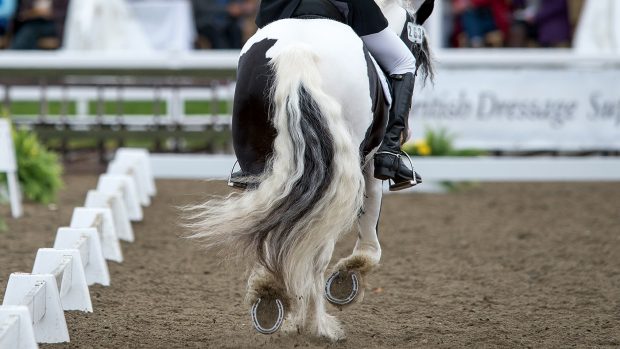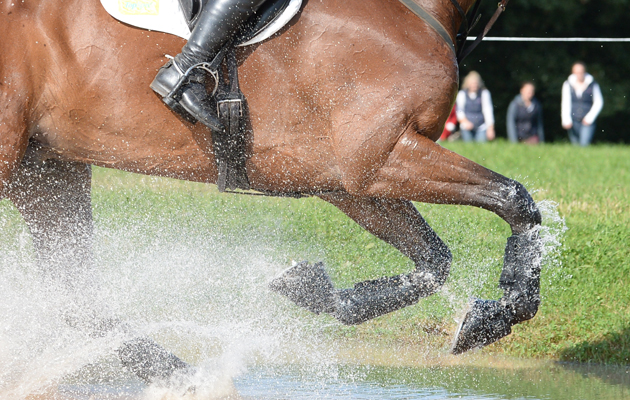Showjumper Charly Edwards, who specialises in breeding, breaking and producing young horses for top sport, explains how to collect your horse’s canter
The dreamy image of a supple and relaxed horse, sailing around the arena in a glorious collected canter evokes sighs of contentment from most — but it takes a lot of work to get there. Training for it properly, so that you and your equine partner are getting the most out of it, can be tricky. International showjumper and coach Charly Edwards breaks it down for us to explain how to collect your horse in canter.
Collection occurs when the horse carries more weight on their hind quarters. There is an increased engagement, lightness in the forehand and self-carriage. It is the last step in the scales of training and is preceded by the other five steps — rhythm, suppleness, contact, impulsion and straightness. To achieve collection, the other scales of training need to be established to a certain extent. So before you get to this point, you’ve probably put in quite a lot of hard work!
As well as performing the scales of training relatively consistently, your horse must have the muscular strength, balance, understanding and acceptance of aids to accurately achieve collection. Work with your coach, a friend or even use video of yourself to assess that all this is in place. If you feel you are lacking in one area, go back to work on it, before progressing again.
When you do get to the point of collection, you will be helping build strength in the horse’s topline. Working in a collected way is so important, because it stimulates those key muscles along the horse’s back, neck and hindquarters, creating strength and suppleness. Not only will that then further the ability to work in a balanced and harmonious way, it can help to prevent injury — such as lameness stemming from back injuries or soreness. Collection will also help to develop a horse’s abdominal muscles and strengthen their core to support their topline through lifting upward towards it.
When collection is established, you will find it helps build the horse’s paces — they will become more uphill and lighter in the contact — which equals self-carriage. This in turn can be really beneficial for helping to improve longevity of a horse’s working life, as they take the impact and pressure off their weaker front limbs and put it back into their naturally stronger hind limbs.
Regardless of your chosen discipline, collection will allow your horse to go in an athletic way, with balance and will increase the “rideability” factor. Here are some training tips to help you on your way.
Variations in pace
- Establish working to medium steps within the chosen pace.
- Repeatedly, move the pace forward and then bring it back.
- Get used to controlling the variation of pace.
- Use walk to canter and canter to walk as it is an extension of the variations in pace.
- Focus on quality over quantity — canter or walk for as many strides as needed until the transition can be executed correctly.
- The upward transition must not be rushed and horses must push off from behind.
- It is the same principle for downward transitions — slow the canter and be in balance and relaxed before you transition to walk.
Introducing collected canter
- Pick up working canter.
- Introduce collecting the stride on the short side — go for approximately five strides.
- Go immediately back to working canter on the long side.
- To shorten horse’s stride, sit taller, lengthen your spine and include multiple half-halts in the rhythm of the horse’s stride (sit taller on the corner as you go in, slow your upper body and slow your seat). As soon as your horse responds give him a pat and canter forward.
You can also use counter-canter to help with straightness and collection and it is instrumental to improve the true canter. It will also help a horse use their backend and to find balance.
A counter canter exercise to aid collected canter
- Start on a large circle on the correct lead.
- Change the rein on a figure of eight remaining on the ‘wrong’ canter lead through the turn and up the long side, then back to change the rein on a figure of eight.
- Repeat this exercise regularly to aim for improvement in balance.
- It helps teach obedience as the horse must be listening to your aids.
- To begin with, start with only do a few counter circles and then gradually add more as the horse gains muscle and strength.
- Naturally on the turns, if ridden correctly, while in counter-canter your horse will collect.

Things to look out for
Sometimes riders pull their horses back to try and “collect”, riding front-to-back, rather than back-to-front. This will produce a shortened stride, but the horse will still have its weight on the forehand. You want your horse to push up from behind and into the contact.
It is physically demanding for a horse to learn collected canter, so don’t ask for too much too soon and ensure your horse is strong enough to carry his weight over his hind end.
Developing collection takes time — Rome wasn’t built in a day.
Collected canter: things to remember
- The horse needs to be ridden from the back end to front end with the energy coming from the hind quarters.
- Remember repetition, praise and reward.
- Work evenly on both reins
- Work in short bursts to start with and slowly build it up, making sure the horse has a break in between — like humans would have between sets at the gym.
- Take videos if possible so you can see your progression as it is easy in any training to think you have become “stuck”.
- Straightness and collection are interlinked, so improving one will help to achieve the other.
- Make sure you have enough leg on, otherwise the horse will lean on the forehand and break the pace.
- You should not be pulling back on the reins when trying to achieve collection.
- Go back to working/medium canter after the exercise as you don’t want your horse offering you a tiny canter with no energy.
You might also be interested in:

#SundaySchool: How do I maintain impulsion in downward transitions?
Dressage rider Alice Oppenheimer explains how to keep a horse energetic and forward, even when slowing down

#SundaySchool: How can I achieve a soft contact?
Dressage rider Jessica Dunn explains how to achieve harmony in the hand and stop a horse resisting the bridle

Subscribe to Horse & Hound this spring for great savings
Horse & Hound magazine, out every Thursday, is packed with all the latest news and reports, as well as interviews, specials, nostalgia, vet and training advice. Find how you can enjoy the magazine delivered to your door every week, plus options to upgrade your subscription to access our online service that brings you breaking news and reports as well as other benefits.




